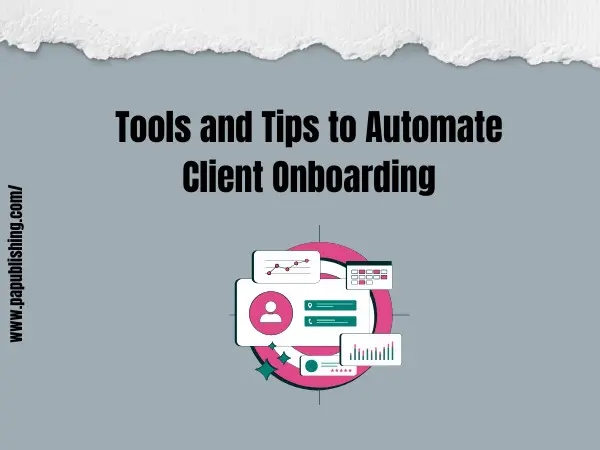16 Tools and Tips to Automate Client Onboarding
Every business, regardless of its size and niche, knows that a client’s first impression counts. This starts from a well-managed onboarding process, which is critical as it sets the tone of this professional relationship. However, as your business grows, it’s hard to process every minor detail manually, and manual onboarding becomes inefficient and prone to errors. That’s where learning how to automate client onboarding comes in.
Continue reading to learn the practical steps to automate the system and integrate automation tools without compromising work efficiency.
Why It’s Important to Automate Client Onboarding?
Automation brings clarity and efficiency, with up-to-date streamlining techniques added to the process. It manages the entire process, from the client finalising, writing, and signing the contract to their integration into the system and service, with improved customer satisfaction and retention.
As you introduce new people to your work environment, you want this to be a smooth and well-structured process. The traditional approach of manual onboarding is only an error-prone and time-consuming process, with the risk of damage to your professional reputation.
Key Areas to Automate Client Onboarding
Before we understand the automation process, we must identify the pain points associated with traditional, manual onboarding.
Some common points include:
- Time-consuming paperwork
- Inefficient communication
- Lack of centralised information
- Scalability challenges
- Poor first impression
The following are the key areas where you can apply your automation skills and yield results and client satisfaction.
Initial Inquiry and Information Gathering
Gathering information is the basis for moving forward with automation and the foundation of a smooth onboarding process. Automating this step can save hours of manual work involving data collection and assortment.
Tools like Content Snare allow you to create custom forms that walk clients through every question. Integrating these forms with your CRM ensures that client records are up-to-date. It helps you automate client onboarding process.
Document Management
Keeping track of heaps of paperwork can be a hassle, especially when dealing with new clients. That’s where you automate client onboarding and make life easier. Instead of chasing down documents over email, you can give them access to a secure online portal where they can easily upload anything without any security fear.
Onboarding and Introduction
Making your customers feel valued from the beginning makes a great difference. A short welcome message, positive, radiant thoughts, wishes, or a personalised video that speaks directly to them can help build trust and comfort. With the right automation tools, you don’t need to do this work all manually.
For instance, you may send them a step-by-step guide outlining what you expect from them, and they can respond to tell you where they need help or have any other queries. Once you automate client onboarding with this strategy, you can save a lot of time, which can be invested in scaling other aspects of the business.
Communication
Staying in constant touch with your new clients is no longer a full-time job. Now, you can keep the communication flowing without lifting a finger, all just by automation.
You can set this up by incorporating simple workflows into your system. For example, as soon as a new client onboards, you send them a congratulatory text, welcome them on board, and send a customised guide of their role. This is an easy way to make all your clients comfortable in the work environment and ensure maximum business up-scaling.
Feedback Collection
Always be open to client feedback, as critique and responses are what make your work environment better. Once your client has settled in, ask them how things went. Feedback is the key to spotting what’s working and what could use a little tweak, helping you improve the client onboarding process.
Tools like Qualtrics let you quickly create simple, user-friendly surveys. To automate client onboarding, set up timed forms, feedback charts, and follow-up reminders.
Step-by-step Guide to Automating the Client Onboarding Process
Implementation of an automated approach is a strategic process. Follow this step-by-step guide to automate client onboarding process.
Define Your Client Onboarding Automation Goals
Before you start automating, take a step back and consider your goals. Are you willing to save time, make the onboarding process smoother, or seek customer satisfaction?
Having clear goals will guide you a long way. They will help you identify who you’re automating for and whether all your customers need the same experience. Therefore, set measurable goals and track the success of your automation efforts.
Map Out Your Current Workflow
As you jump onto the automation bandwagon, make sure you document your existing onboarding workflow. Break it down into key stages such as:
- Welcome emails
- Construct signing
- Data collection
- Account setup
- Introduction to the team
Listing these tasks will help you identify the repetitive patterns and list tasks that can be automated. For instance, if your team manually sends the same welcome text to every client, this can be automated with tools like HubSpot.
Choose the Right Automation Tools
With so many automation tools on the market, it’s normal to feel overwhelmed. However, it’s important to know that not every tool is the right fit for your business. Some might be too expensive, and others might not have the desired features.
That’s why it’s important to consider your budgeting, suitability, data security, and the growth it can bring to your business.
Use E-signature Tools for Agreements
Use E-signature tools like DocuSign, which make contract signing easy and allow you to receive real-time updates on signature status.
Integrate Online Forms and Client Portal
Platforms like Typeform, Jotform, and Tally let you design interactive forms that collect essential details such as company information, billing details, and goals and expectations.
Additionally, adding a dedicated client portal gives 24/7 access to onboarding materials, timelines, and project updates.
Implement the Automated System
Eventually, it’s about time you implement the automation in your system. Think of it as a soft launch, and look for any errors, bugs, or confusing steps that may need improvement.
Once you’re confident that the automated system is in top shape, you can roll it out to all new clients.
Integrate With Other Systems
To automate client onboarding process with efficient management, centralize everything using HubSpot or Zoho. These tools track client progress and make sure nothing slips through the cracks. Furthermore, pair it up with a powerful project management system like ClickUp, so you can run your business better than ever.
With guidance, templates, and targets all combined in one place, your team will always know what to do next without confusion or extensive training programs.
Track Performance and Optimize
Once your automated onboarding system is in place, continuously measure its performance. Look for:
- Drop-off points in the onboarding journey
- Time to completion
- Feedback from clients
- Internal team feedback
Best Practices for Automation of Client Onboarding
If you’re looking for maximum yield, the following are the best practices to automate the client onboarding process.
Prioritise Client Experience
The main reason for automation is to make things easier, more efficient, and smoother for your clients. So, if a tool saves you time but creates annoyance for the client, it’s better to drop it.
Maintain a Human Touch
While automation streamlines processes, it’s important to maintain a human element in client interactions. Clients should always have direct access to human support whenever needed.
Regularly Review and Update
Automation is not something you set up once and forget. Track data and customer behaviours to monitor how your onboarding process is performing. This will help you spot what’s working best for you and where things can improve.
Clear Communication
Timely updates and clear communication make automated onboarding feel personal and trustworthy. Use simple language in your texts to show what’s been done, what’s to be done, how to do that, and where to get help.
Conclusion
Learning how to automate client onboarding is no longer optional. Scaling your business while maintaining high standards of client care has become a necessity. By implementing automation through the key stages of the onboarding process, businesses can manage troublesome technical tasks in the blink of an eye.
Remember, automation never replaces human connection. Instead, it amplifies it by freeing up your team to focus on what matters more.




